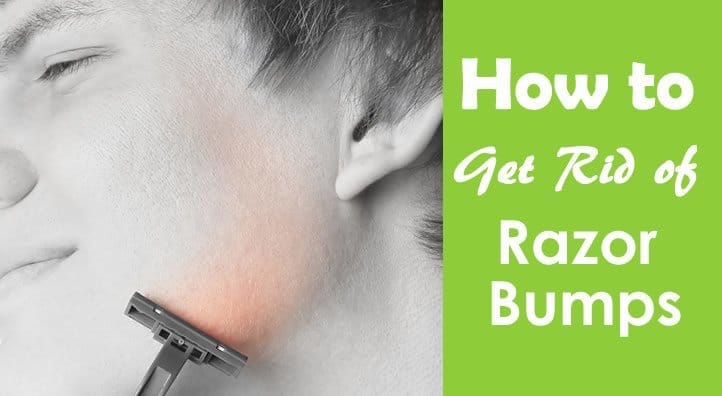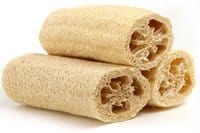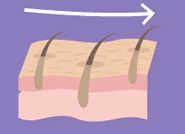
Have you ever had red, irritating and itchy shaving bumps after shaving? Well, you’re not alone – this is the number one complaint that people have about shaving. All too often shavers end up with razor bumps, redness, ingrown hairs and even acne.
The tragic thing is that it can be completely avoided just by following a few simple steps.
Follow the instructional infographic from Hair Free Life below to eliminate shaving irritation for good. Beneath the graphic you’ll also find a few steps that you must follow to banish razor bumps permanently:

Eliminating Razor Bumps: Step by Step
The simple shaving irritation eliminating process consists of the following steps:
- Cleanse
- Exfoliate
- Soften
- Minimise Friction
- Post Shave Treatment
Let’s take a closer look at each of this steps in more detail:
Step 1 – Cleansing the Skin

It goes without saying that for the best shave possible you should ensure that the treatment area is completely clear of dirt.
We recommend that you have a hot shower and thoroughly clean the area to be shaved. However if this isn’t convenient you can use a hot, damp flannel and gently rub on the treatment area for 30 seconds.
The hot water gives the additional benefit of opening up the pores, putting your hair in the perfect condition to be shaved.
Step 2 – Exfoliate

Exfoliation prior to shaving is one of those things that you think won’t make a difference, but actually makes a huge difference and can completely eliminate shaving irritation by itself.
The main reason to exfoliate before shaving is to minimise the chance of ingrown hairs.
While most people understand that exfoliating is important, what they don’t realise is that there are numerous different types of exfoliation and if you choose the wrong one then it can do more harm than good.
The two main types of exfoliant are chemical and mechanical. For the purposes of shaving, chemical exfoliation is far too harsh and should be avoided. Instead, we recommend that you invest in a loofah. Loofahs have just the right level of friction in order to remove dead skin cells without damaging the skin.
What is a Loofah? (Luffa)
 Loofahs are pale coloured, fibrous materials, made from tropical fruits. They have a rough texture when dry that softens up somewhat when wet and are commonly used for scrubbing and exfoliation. They can be picked up at most superstores / health shops and commonly retail for less than $10.
Loofahs are pale coloured, fibrous materials, made from tropical fruits. They have a rough texture when dry that softens up somewhat when wet and are commonly used for scrubbing and exfoliation. They can be picked up at most superstores / health shops and commonly retail for less than $10.
Recommended Loofah:
Step 3 – Soften the Skin

Heat and moisture are the two best ways to soften the skin prior to shaving. You’ve already had a hot shower/applied a warm flannel to the area that will be shaved so you now need to apply shaving cream as a final pre-shave step.
The shaving cream acts as a layer of protection between the razor blades and the skin. Most people use the pre-made canned shaving cream – these seem ideal because you can simply squirt and you’re done. However, these types of shaving cream are often made with preservatives and butane/propane – substances that you definitely don’t want to come into contact with your sensitive skin.
Instead, opt for a natural shaving soap or cream that you can whip up into a lather yourself. This takes 20 seconds of elbow grease while you generate the lather but your skin will certainly thank you for it.
How to Whip Up a Lather
There are two types of shaving cream that we recommend for use if you have sensitive skin and want to limit irritation:
Notice that neither of the products come pressurised and ready lathered in a can. You really want to avoid “ready made” shaving foams and gels and instead use either of the above products to generate your lather.
With both the above products, you have to generate the lather yourself by using a shaving brush and bowl:
Here’s what you need to do to generate your lather ready for shaving:
- If you’re using the shaving cream then you can squeeze a bit of the shaving cream into the shaving bowl. You’d usually not need much more than a few pea sized drops.
- If you’re using the shaving soap then you “load the brush” by swirling the brush around the pot in a circular motion for 20-30 seconds until the brush is “loaded” with shaving soap.
- For both methods, you take the brush to the bowl and rapidly move the brush in a circular motion for roughly 30 seconds or until a lather starts to form
- You can add water if needed to make the perfect thickness for your lather.
This great video demonstration shows you in greater detail how to prepare your lather:
If you’re new to safety shaving, it may also be worth checking out this safety razors for beginners product list.
Once you’ve prepared your lather, apply generously all over the area of skin that will be shaved. We recommend using a shaving brush to apply the lather in order to help the hairs stand up ready to be cut.
Step 4 – Minimise Friction

You are now ready to begin shaving. There are a few important things to take into account when it comes to shaving technique to minimise irritation.
 1. It’s highly recommended that you shave “with the grain.” Even if you decide that you really don’t want to miss the “closeness” that shaving against the grain gives you, you should do a multi-pass shave and shave with the grain on the first pass.
1. It’s highly recommended that you shave “with the grain.” Even if you decide that you really don’t want to miss the “closeness” that shaving against the grain gives you, you should do a multi-pass shave and shave with the grain on the first pass.
Shaving against the grain, especially if the hairs are long, is a major cause of ingrown hairs and very commonly causes razor bumps and, in some cases, acne.
2. Make sure your blade is sharp. The razor should never feel like it’s pulling or “tugging” the hair. It should always be sharp enough to cut. This may mean that you need to sharpen your blade or regularly change blades. This is especially true if you are shaving an area of thick, coarse hair.
Shaving Bump Destroyer – Make the Switch to A Double Edged Razor
The Woes of the Cartridge Razor
 The modern day cartridge razor is heavily advertised and used by a large majority of the population because of its ease of use and convenience. Not only is it practically impossible to cut yourself, but the 3 blade (and more) cartridges mean that you only need to do one pass for a close shave.
The modern day cartridge razor is heavily advertised and used by a large majority of the population because of its ease of use and convenience. Not only is it practically impossible to cut yourself, but the 3 blade (and more) cartridges mean that you only need to do one pass for a close shave.
Sounds great right?
However, what most people don’t realise is that the multi blade approach to shaving is actually very irritating to sensitive skin. In fact, many people with sensitive skin have reported that their razor bumps completely disappeared after switching away from the modern day cartridge razor to a double edged safety razor.
Why People with Sensitive Skin Are Flocking to Double Edged Safety Razors
The double edged safety razor is a razor that contains a doubled edged blade. Contrary to the name, only one edge of the razor actually comes into contact with the surface of the skin at any time.
Typically, you’d do a number of strokes with one side of the blade, flip it over and do a number of strokes with the other side. You’d then dip the razor in some water to remove the cut hairs and start the process again.
Typically you do what’s called a multi-pass shave with this type of razor. This means that you shave the area two or three times to get the desired result. The most common method is:
- On the first pass you go with the grain (with the direction that the hair grows)
- On the second pass you go across the grain (across the direction of hair growth)
- On the third, optional, pass you go against the grain (against the direction of hair growth).
Author story: Making the switch to a double edged safety razor literally destroyed my shaving irritation overnight. As someone with acne prone skin, I had suffered from shaving irritation my entire life.
After shaving, I would always come out in big red blotches and a few hours later the shaving bumps would appear. More often than not, this resulted in acne that would last for weeks before finally clearing. Shaving was a huge nightmare for me.
At my wits end, I decided to experiment with double edged safety shaving after reading about the success that some people were having online. In my first shave I made some technique mistakes by pressing down too hard and not finding the correct head angle (it requires a different technique than with the cartridge razors)…
However, once I had figured out the technique, for the first time in my life I experienced irritation free shaves. To my absolute surprise, I found that I could even shave against the grain without any issues whatsoever – something that would have been suicidal with my old Gillette Mach 3 razor.
To learn more about how to shave with a double edged razor, check out this video below:
Step 5 – Moisturise

The last step of the process is to make sure your skin is sufficiently hydrated after the shave
One of the important things to understand is that there are two main reasons for skin irritation after shaving:
- You are getting tiny infections in each pore
- Your skin is too dry and is reacting to not having enough moisture
Using a good post-shave moisturised with vitamin E and Jojoba oil is really important to help the skin recover from the stresses of shaving.
Recommended moisturiser:
Summary of the Irritation Free Shaving Régime
Here’s the entire régime in a nutshell:
- Cleanse the area to be shaved of dirt (we recommend taking a shower)
- Exfoliate with a mechanical loofah to remove dead skin cells
- Soften the skin with non canned shaving cream
- Stop using cartridge razors and switch to a double edged razor
- Make sure the blade is sharp
- Shave with the grain for the first pass
- Rehydrate the skin with a moisturiser complete with vitamin E and Jojoba oil
Here are some additional bonus tips that you can use to ensure an irritation free shave:
Use a Slant Razor & Sharp Blade Combination for Thick, Coarse Hair
If you are trying to remove really coarse hair then you will likely be better off with a razor blade that’s towards the sharp end of the spectrum. Coarser hair is more difficult to cut, and most people with such hair find that often the hair is pulled out rather than cleanly cut.
If shaving with a double edged razor, then you may wish to consider experimenting with Feather razor blades. These blades are notorious for being the sharpest on the market and are very popular for people with thick hair growth.
You may also wish to experiment with a slant bar safety razor. These razors are typically more aggressive than the standard safety razor – they require less downward pressure and work well with the sharper Feather blades.
Of course, if you’re going to use a slant bar + Feather blade combination then you need to pay close attention to your technique so that you don’t cut yourself.
Recommended products for shaving thick, coarse hair:
Use a Smooth Razor Blade for Light Density Hair
If you have less dense hair growth then you won’t usually require the sharper blades and instead can choose a particular brand of blade that is “smooth”.
The Derby blades are known for being the smoothest on the market – use these in conjunction with a standard safety razor for a nice smooth shave.
Recommended product for shaving light density hair:
Body Shaving – Invest in a Long Handled Razor
Double edged shaving is becoming more and more popular amongst women who want to shave their legs, under arms and other parts of the body.
There are certain brands of razor that have extended handles allowing you to more easily reach the body parts that need shaving.
Recommended product for female body shaving:




Leave a comment